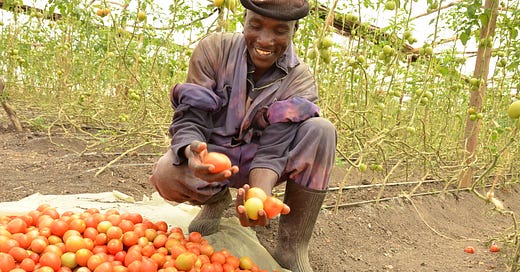Africa’s biggest tomato producer is also its biggest importer
Fifty percent of tomatoes harvested every year in Nigeria never make it to the market due to poor storage and a lack of processing options. The same situation is at play from West to East Africa.
Tomato is one of the most consumed vegetables in the world. Though commonly eaten as a vegetable, it is botanically a fruit. Tomatoes are the major dietary source of the antioxidant lycopene, which has been linked to many health benefits, including reduced risk of heart disease and cancer. In 2018 the total number of tomatoes produced worldwide was estimated at 188 million tons. The tropical and subtropical climates of Africa are amongst the notable growing zones with Egypt (North Africa) and Nigeria (West Africa) holding the 5th and 10th position respectively on the global production output (tons).
Between 1971 and 2020, production in Africa grew substantially from 3.29 million to 22.2 million tons rising at an increasing annual rate that reached a maximum of 19.47% in 1975 and then decreased to 1.85% in 2020. Paradoxically, West Africa is the continent’s third largest importer of tomato paste, spending about 360 million USD per year on imports between 2016 and 2017. Sahel Capital, a fund manager and advisory firm focused on West Africa, reported that 40-50% of tomato production in Nigeria is lost due to issues with poor handling, processing and preservation practices.
To reduce the loss and preserve foreign exchange, Sani Dangote installed Africa's biggest tomato processing plant with a capacity of producing 1,200 tons of tomato paste daily. The factory was meant to reverse Nigeria’s dependence on imports of tomato paste from China and increase local production. Despite engaging over 5,000 farmers whose output would be purchased after harvest, the plant shut in 2017, re-opened in early 2019 and struggled until it became fully operational in February 2020. In addition, Erisco Foods opened a tomato paste plant in February 2016. It also closed its plant in November of that same year due to a scarcity of the dollars it needed to import machine spare parts and raw materials after Nigeria slumped into a recession.
The Dangote plant was to help Africa’s most populous nation cut down the 300,000 tons of tomato-paste imports from China by using an estimated 900,000 tons of tomatoes lost yearly post-harvest, for lack of storage and processing facilities. But farmers have not been able to supply the factory with the volumes needed to run at capacity.
Increasing yields
At the heart of the problem is the lack of a steady, unhampered supply of raw tomatoes. Small- and medium-scale farmers, who account for 90% of domestic production, are grappling not only with a lack of quality seeds and fertilizer but also with poor yields, pests, and staggering post-harvest losses due to poor storage and transportation infrastructure.
China, by far the world’s largest tomato producer, achieves yields of nearly 50 metric tons per hectare, India has yields of about 20 metric tons per hectare while the United States, the world’s third-largest producer, has yields of 73 metric tons per hectare. According to PwC, between 2006 and 2016, tomato yields in West Africa averaged 5.47 tons per hectare, compared to the global average of 38.1 tons per hectare. In 2012, Nigeria had yields of less than 6 metric tons per hectare. Global postharvest losses of tomatoes are as high as 30%, but this is much higher in developing countries like Nigeria due to improper handling procedures and a lack of methods to increase shelf life. The fragility of the vegetable coupled with its short life span facilitates its wastage across the global supply chain. In African countries, inadequate logistics and storage exacerbates the volume of post-harvest loss.
Improving handling practice in tomato supply chains
Post-harvest begins where production ends, that is at harvest. Good practice in harvesting and in post-harvest handling is essential in maintaining quality (fresh appearance, color, flavor and nutritional value), and extending shelf-life. Causes of off-farm losses include poor access roads, inappropriate transportation system, lack of processing factories and reliable market information. Using low-cost intermediate technology intervention can help reduce some of these losses and make tomato production a more profitable venture in Africa. Postharvest losses are a complex problem, and an integrated solution is needed to mitigate losses across the value chain. To reduce loss, farmers and traders need to be educated on best harvesting practices, postharvest handling and storage. Also, leveraging existing relationships between value-chain actors for example: Agro dealers & farmers, farmers & processors, and processors & buyers to integrate market linkages can promote efficient resource utilization and secure livelihoods of smallholder farmers.
Many factors hinder the production of vegetables, including poor husbandry techniques, shortage of seeds at the required time, a poor extension service, insufficient use of fertilizers, unreliable rainfall, inadequate irrigation facilities, a lack of organized vegetable processing, marketing and the low gains for producers.
In conclusion, the fruit and vegetable sector is in need of a disruptive storage and cold technology solution that is accessible and cost-effective. How can we leverage technology to build solutions that address the post harvest loss, low incomes of smallholder farmers and reduce imports of tomatoes concentrates?





